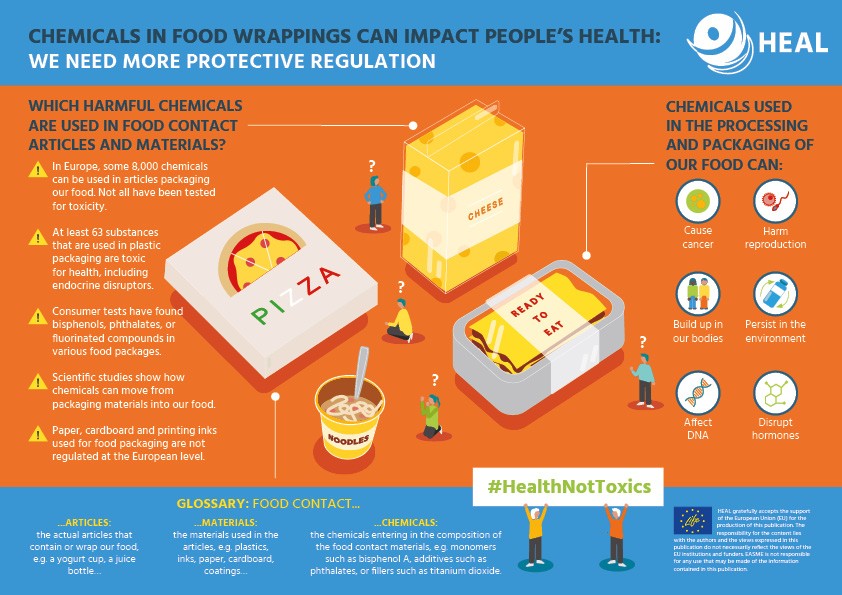HEAL welcomes the call from 250 scientists urging the European Commission to follow scientific recommendations and include provisions to account for the effects of chemical mixtures to better protect health in the upcoming revision of REACH, the EU’s regulation for chemicals.
Nobody should ever have to worry about toxic substances making their way into our food. Yet, if you ask around, most consumers have no idea about the composition of the packaging wrapping their food and drinks, and how this might affect them. Current loopholes in the European legislation on food contact materials have as a result that its objective to provide a high level of protection for health is not fulfilled.
Have you ever wondered whether harmful chemicals are present in the plastic wrappers around the meat and cheese you buy in your local supermarket? Or whether it is safer to buy your yogurt in a plastic pot or in a glass jar with a plastic lid? Well, most people don’t know. And the reason for that is that there are thousands of chemicals in the materials coming into contact with our food through packaging.

This infographic is available for download in English (pdf and jpeg), French (pdf and jpeg)*, Spanish (pdf and jpeg)* and German (pdf and jpeg).
The European regulation on food contact materials has been in place since 1976. It has severe loopholes that explain why potentially hazardous substances make their way into our food through leaching or migration and then into our bodies, with potential health effects over the long-term.
Some of the most concerning loopholes that HEAL has been calling for action on are the following:
- Most materials currently used for food packaging are not covered by the current regulation. Only five materials are covered: these are ceramics, regenerated cellulose film, active and intelligent materials, plastics, recycled plastics. Widely used materials such as paper and boards are overlooked.
- Many chemicals are not assessed for safety by public authorities. This includes so-called non-intentionally added substances (NIAS), that are present as impurities or by-products of manufacturing processes.
- Numerous chemicals harmful to human health are overlooked, including substances identified as of very high concern (SVHC) under the REACH legislation.
- Endocrine disrupting chemicals (also known as hormone disruptors or EDCs) are not addressed at all.
- Recycled materials are not assessed for their adverse health effects.
- The real-life exposure conditions to chemicals as well as the additive effects between the various chemicals used in one single food package are overlooked in the current risk assessment process.
- The current regulatory process for food contact materials is not transparent enough and suffers from an unbalanced stakeholder access, with limited access for civil society groups.
- By not being aligned with the REACH regulation, the regulation on food contact materials is not delivering on the better regulation objectives set by the European Commission itself
HEAL, together with its members, is dedicated to creating a toxic-free environment where nobody should have to worry about the presence of toxic chemicals in their food and products and their effects on our health. When it comes to food contact materials, here are some examples of how we are working towards this goal:
- To illustrate how chemicals in food wrappings can impact people’s health, HEAL developed an infographic (available in English, German, French and Spanish*) and a set of fact cards (in English, German, French, Czech and Spanish*), available for download.
- In May 2019, HEAL responded to a public consultation opened by the European Commission with the aim of evaluating the EU’s legislation on food contact materials.
- The European Commission launched the foundational roadmap to the ongoing evaluation effort of the EU’s legislation on food contact materials in late 2017. HEAL took this opportunity to explain our problems with the current legislation.
- Our vision for Europe leading the way towards a non-toxic environment explains the problematic use of harmful chemicals, and what should be done to motivate change.
- Our concerns about the chemicals present in food contact materials are explained in an easy-to-use briefing about the topic. First published in 2016 and updated in May 2019, this document forms the basis of our work on food contact materials.
- Together with other NGOs, we support calls for new EU-wide legislation on food contact materials, based on the following five key principles:
- A high level of protection of human health
- Thorough assessment of chemicals in materials and final articles
- Effective enforcement
- A clean circular economy based on non-toxic material cycles
- Transparency and participation
- To bring you the latest news and science on food contact materials, HEAL has joined up with CHEM Trust and Zero Waste Europe to produce a monthly ‘Food for Thought’ newsletter. Click here to read the May 2020 edition, and subscribe today!
* We thank WECF France, ARNIKA, and Fundación Alborada for supporting the translations into French, Czech and Spanish.


